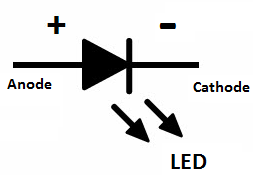Light Emitting Diode (LED)
A light-emitting diode (LED) is a semiconductor device that emits visible light when an electric current passes through it. The light is not particularly bright, but in most LEDs it is monochromatic, occurring at a single wavelength. The output from an LED can range from red to blue-violet. Some LEDs emit infrared (IR) energy, such a device is known as an infrared-emitting diode (IRED).
A light emitting diode (LED) is an example of an Optoelectronic junction device, which implies that it is used as an electrical to optical or an optical to electrical transducer. It works on the effect of suitable voltage being applied to the diode which leads to the generation of light in the form of photons. It is implemented over a heavily doped p-n junction diode by fabricating a transparent window on top of it which allows the generated light to be emitted out of the diode.

When a forward bias voltage is applied to a diode both electrons and holes move in opposite directions where they are minority carriers i.e. electrons move from n-side to p-side and holes move from p-side to n-side. Due to this movement, the equilibrium is disturbed and consequently the concentration of minority carriers at the boundary of the junction increases. Because of this excess presence of minority carriers at the boundary junction, they combine with majority carriers and this combination releases energy in the form of photons. The photons that are emitted have energy equal to or greater than the band gap energy for the diode and hence they are able to escape from it in the form of light.
The intensity of the light emitted is directly proportional to the intensity of the bias voltage being applied to the diode. However after reaching a peak value, on further increase in the bias voltage the emitted light intensity decreases. Therefore it is necessary to apply the bias in such a manner that maximum efficiency is obtained.
